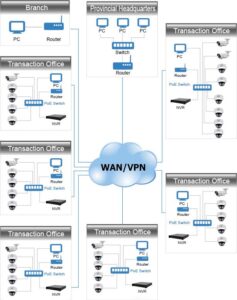
Banking industry is one of core market sectors in video surveillance industry. Banks need high grade video surveillance systems to monitor their transaction offices and branches. IP technology is today’s trend. Many new security installers/integrators really want to know how to setup/design IP video surveillance systems for bank.
Generally, a typical network video surveillance system consists of network cameras and NVRs, as well as network switches (or PoE switches). Because this system relies on network to transmit data, so basically designing the IP video surveillance system is similar to hierarchical network topological routing. Since Power over Ethernet technology prevails in IP video surveillance solutions, we highly recommend our users to choose network equipment supports PoE. PoE can bring the users many benefits from both a network efficiency standpoint as well as a cost standpoint. With PoE, the constraint of having AC power outlets is eliminated, and centralized power management can be achieved.
BANK SECURITY SOLUTION CHALLENGES
MEGAPIXEL IMAGE QUALITY
Commercial users now require megapixel cameras support full HD 1080p video resolution, also can provide sufficient reliability for long-term operation. Additionally, network cameras must can withstand extreme weather conditions to support different kinds of environments and applications: water-resistant, vandalism, indoor and outdoor, extreme low temperature, etc.
SYSTEM SCALABILITY
Usually, bank security requires a distributed structure with centralized management. And the solution has to be scalable, allowing users to increase the number of network cameras at individual locations or expand the coverage of the solution to include even more locations.
SYSTEM RELIABILITY
Reliability is the big concern to bank security solution, and this kind of solution must has the feasibility of setting up a truly IP video monitoring solution that allows simple installation and free-maintenance. Project installers are well aware of the impact on system performance and stability generated by the large bandwidth required by megapixel video streams.

CASE STUDY 1
Bank SinoPac, has 129 branches in Taiwan, and it further expanded operations into China, Hongkong, USA, Vietnam. The company upgraded its existing analog surveillance system to HDTV IP video surveillance framework. Apparently, HDTV IP video surveillance system has become the today’s main trend which offers many benefits in terms of video calrity and recognition capabilities. In this project, Bank SinoPac chose to install seventy-five 1080p HD IP bullet cameras which cover 15 Bank SinoPac branches. Those HDTV network cameras were installed in the teller area of each bank SinoPac branch to achieve a comprehensive coverage of the designated area. With help of high definition, both money transaction and legal document process can be recorded precisely and clearly. Full HD 1080p cameras with WDR function were installed to monitor changing lighting environment like bank entrances.

CASE STUDY 2
BMCE bank of Morocco choose IP video surveillance system for its new bank branches. The bank surveillance solution includes a number of outdoor bullet cameras to monitor bank’s perimeter area, these outdoor bullet cameras come with IR function to provide day/night video surveillance. WDR IP cameras were installed to secure each bank entrances. Offering 260/180 degree video surveillance, the panoramic network cameras are suitable for bank halls and branch offices. In addition to HD video monitoring, network cameras can offer rich video analytics including:
- An object left behind or removal from a pre-defined region is detected and an alarm is triggered for prevention of crimes;
- Line crossing detection in sensitive area to protect sensitive area;
- Vehilce license plate number analytics can detect and recognize a vehicle’s license plate;
- Abnormal face detection and alarm generation for detection of exceptional ATM operations;
- Detection of items attached illegally for effective prevention of criminal purposes in ATM;
Source: Unifore.net



































































